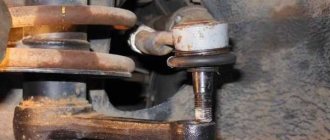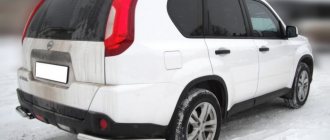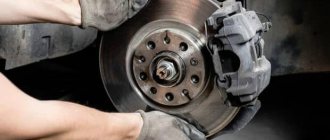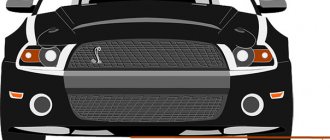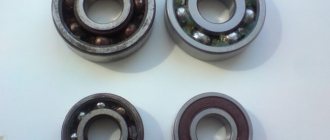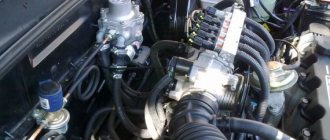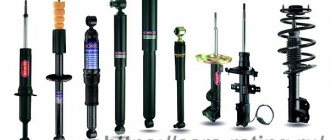Design and diagram of the rear axle gearbox
A gearbox is a complex technical device consisting of moving parts that interact with each other.
The gearbox is located in the rear axle. Therefore, first let’s look at the cross-sectional diagram of the rear axle.
- 1-differential bearing;
- 2-breather;
- 3-differential housing;
- 4-driven final drive gear;
- 5-satellite;
- 6-shaft gear;
- 7-bolts securing the gearbox to the rear axle housing;
- 8-drive gear bearings;
- 9-cuff of the drive gear flange;
- 10-flange;
- 11-nut of the drive gear;
- 12-ring dirt-repellent;
- 13-spacer sleeve;
- 14-adjusting shim (ring);
- 15-drive gear;
- 16-axis satellites;
- 17-gearbox housing;
- 18-beam rear axle.
The design of the rear axle gearbox includes the following main parts:
- drive gear;
- driven gear;
- direction pin;
- oil seals;
- drum;
- bearings and their fastenings;
- locking plate;
- breather;
- shank.
The main gear consists of 2 gears: drive and driven. Their gearing is hypoid, which is why the gear teeth have good sliding.
To make it clear what a hypoid, or hyperboloid, or spiroid engagement is, I will give the types of gear engagements.
Hypoid gearing requires high precision in manufacturing, but during operation it provides quiet operation compared to cylindrical gearing.
The drive gear first receives power from the engine, then the driven gear. Gear sizes affect the gear ratio and rotation speed.
In simple words, any gearbox is a device that reduces the speed received from the engine.
The main gear of the rear axle gearbox can be of two types:
Double GP, in turn, happens:
The dual GP has a simple design. The main parts of the double type GP take the main load and have a larger gear ratio.
As for the spaced type GP, it has a complex design, is smaller in overall dimensions and is more efficient in operation. Installing a spaced GP allows you to increase ground clearance (clearance). There are also special spacers for ground clearance, which can be placed under the springs and shock absorbers to make the car rise higher.
Types of single gears:
- Cylindrical. This is the simplest torque transmission scheme. The gears are in the same plane. This gearing ensures maximum efficiency.
- Hypoid. Manufacturing is more complicated, the design is lighter and lighter in size, and the efficiency is average.
- Conical. The gears in a bevel gear are located perpendicular to each other, which is why the dimensions are so
- Worm. This transmission is silent, operates softly, but produces the lowest efficiency value.
In complex structures, the most common type of transmission is hypoid. The gears in it are located at a certain angle to each other. Due to this arrangement of contacting gear teeth, such a unit operates smoothly and has less wear.
The differential is located between the wheels and works in tandem with the final drive (MG). The differential device includes:
- driven gear;
- axle gears;
- satellite gears.
The wheels receive their driving rotational force from the axle shafts, which in turn receive their rotational force from the driven gear.
The differential is the power distributor between the axle shafts. It allows the axle shafts and wheels to rotate at different angular speeds. This operating principle is used in rear-wheel drive cars.
How to make a homemade gearbox for a walk-behind tractor
To independently assemble the converting device on a walk-behind tractor, you need to stock up on the following tools:
Also, using preliminary calculations, you can estimate the dimensions of the future transmission device.
To make the correct calculation, determine the parameters of your engine. For calculations it is necessary to clarify several data:
Let's take a simple example: the engine power at idle, taking into account an increase of 10%, is 600 rpm, and to ensure a speed of 3 km/h, a rotation speed of 200 rpm is required. Therefore, the design gear ratio is 3:1. In other words, to reduce the rotation speed of the axle by a factor of three to ensure a travel speed of 3 km per hour, the torque increases three times.
Step-by-step instructions for assembling a chain gearbox
If you have certain skills, you can make any type of gearbox with your own hands, but the easiest way is to assemble a small-sized mechanism with a chain drive. Materials for it are easier to find and are reliable in operation.
To make a homemade chain mechanism, stock up on the following spare parts and materials:
You can use an old gearbox housing of a suitable size as a protective casing, drilling holes in it for mounting.
If the calculation of the gear ratio is done correctly, then the gearbox, carefully assembled taking into account all the design features of your walk-behind tractor, will ensure the smooth operation of the mechanisms no worse than its industrial counterparts.
Gearbox Maintenance
The rear axle gearbox operates under increased loads. The service life of the rear gearbox depends on periodic maintenance and operating mode.
A sign of a malfunction of the rear axle gearbox, which should be diagnosed and, if necessary, repaired, is the appearance of noise. Gearbox noise is a hum that is easily felt while driving and which bothers the ears when driving over long distances.
Usually, when gearbox noise appears, you always have to make a major overhaul or replace it completely.
Depending on what gear the car is driving in and at what speed, the noise may vary.
What gearbox noises can be:
- incessant noise from the rear of the car;
- noise during car acceleration;
- noise when turning;
- noise when braking.
The procedure for repairing or replacing a complete unit:
- Prepare a standard set of keys.
- Drain the oil from the gearbox by unscrewing the drain plug.
- Remove the wheels.
- Remove the brake drums.
- Remove the pads.
- Unscrew the axle shaft mountings with a socket wrench.
- Remove the axle shafts.
- Disassemble and remove the driveshaft. We do this in this order:
- Place marks on the cardan flange and gearbox flange to avoid imbalance after assembly.
- Unscrew the bolts that secure the shaft.
- During assembly, use new nuts to avoid possible damage on the road (cardan shaft breakage).
- Unscrew the gearbox mountings to the rear axle using a socket wrench.
- We install a new gearbox or repair it.
- After assembly, fill in new oil for the gearbox.
Do-it-yourself gearbox for a walk-behind tractor
Enthusiastic farmers are wondering: how to make a geared walk-behind tractor with your own hands? The question is relevant, since making such a miracle from materials and parts available on the farm is sometimes easier and cheaper than purchasing a regulator assembled by the manufacturer at the factory.
Indeed, in the “invention” of the converter there are no super complex manipulations, and a tool made on a walk-behind tractor with your own hands always serves correctly, however, first of all, you should acquire some tools:
Assembly, or rather, preparation of the converter begins with welding the housing. It can be made of metal plates. Sometimes they use a housing from the Ural shaft with its subsequent modification.
DIY walk-behind tractor gearbox
Oil in the walk-behind tractor gearbox
Just like any mechanism, the lubricant to be filled is individually suitable for the geared walk-behind tractor. Its quality directly affects the performance of the cultivator. Depending on the conditions of use, you should choose the oil individually, but fortunately, universal brands like Motul come to the rescue, and the user can’t go wrong with the purchase.
However, there are also much more expensive models
What matters is how pricing is structured. And, above all, the price depends on the number of functions that the converter is equipped with
You can't ignore the quality of its build - it also greatly affects the cost. Power and the ability to use reverse are also important.
These are the general characteristics of the gearbox, but there are many more. From which it follows that the gearbox on a walk-behind tractor is a complex mechanism, the choice of which should not be mistaken.
Design and principle of operation
main gear
The main gear can be single or double. The single gear transmits torque to the wheels of the car using one gear pair, and the double gear – using two. Single gear, in turn, can be:
For a cylindrical main gear, the gears are located in the same plane, while for a bevel gear, they are perpendicular to each other. The advantages and disadvantages of the main modifications to single final drives are listed in the following table.
Modifications of single final drives:
| Modification | Efficiency | Noise level | Dimensions |
| Cylindrical | Maximum | Maximum | Large |
| Conical | High | High | Average |
| Hypoid | Average | Average | Average |
| Worm | Short | Short | Compact |
The double main gear can be central or spaced. The central one has a simpler design, a large gear ratio and a greater load on all elements of the system. The spaced one has a more complex design, it is more efficient in operation and compact.
Differential
The cross-axle differential distributes torque between different axle shafts. If the car is slipping or slipping, the differential helps it cope with this problem by allowing the wheels to rotate at different speeds.
The cup (3) contains the satellite gears (4) and half gears (5). The cup is connected to the driven gear (2). The gear, in turn, receives torque from the main gear drive gear (1). The cup, with the help of satellites, transmits rotation to the axle shafts that drive the driving wheels of the car. The operation of the satellites provides different angular velocities. The amount of torque is unchanged.
A similar device is implemented in most rear-wheel drive cars, such as VAZ-2106, VAZ-2107, Gazelle. It has proven its reliability during operation in the most difficult conditions.
Making a reverse gear manually
Now the main task: how to make your own gearbox for a walk-behind tractor so that the engine is powerful and reliable? To simplify the work in the manufacture of the mechanism, you can take a ready-made sample, for example, from Dnepr or Ural motorcycles. The following details must be present:
- ruler and calipers;
- straight and oblique screwdriver;
- metal file;
- pliers, wire cutters;
- hammers and vices of different sizes;
- rubber gaskets, preferably several different ones.
First you need to prepare the housing for the reverse gearbox. A two-inch fitting elbow works well for this. You can make it yourself; to do this you need to weld a body of metal plates.
They also use a generator shaft from a Ural motorcycle. It is simply masterfully refined. Gears for the gearbox can be used from the Druzhba chainsaw. Remove the end stop in one of the shafts, then drill a hole of the required diameter. It is important to remember that to perform this work you must have all the necessary tools, since the quality of the drive depends on this.
Mount the other gear shaft, along with bearings and its cage, into the gearbox housing on the opposite side. And already on the output shaft the owner must install a pulley that ensures rotation using a V-belt drive. Finally, bearings - fans - are attached to the hood frame using welding.
This is how you can design a small tractor for your household yourself with minimal investment.
Malfunctions
Causes of malfunctions
The rear axle gearbox is a complex mechanism consisting of a large number of elements. Failure of any one of them can lead to failure of the entire system.
- System overload. One of the most common reasons for failure of the rear axle gearbox is the frequent excess of the required load on the vehicle. For example, when towing heavy vehicles or other loads. During towing, the load on all elements of the system increases significantly.
- Play in crosspieces. Many motorists note that after 5-6 years of using the car, play appears in the crosspieces. This occurs due to increased engine detonation, unregulated ignition and the resulting shocks and shocks. Therefore, during repairs, they carry out diagnostics of all elements of the chassis and do not limit themselves to replacing the transmission mechanism.
- Lack of lubrication. If there is no oil in the rear axle gearbox, it may jam due to overheating. Steel parts may burst or teeth on gears may break. To avoid such problems, it is necessary to keep the lubricant level under control.
- Production of bearings located in “stockings”. This malfunction appears after many years of using the car. It can cause bending of shafts and destruction of gears. As a result, the rear axle gearbox will not be suitable for repair.
Let's not forget about the differential
The structure and design of the gearbox cannot be fully understood without paying attention to such an element as the cross-axle differential. As already mentioned, its purpose is to distribute the resulting torque between the axle shafts. In fact, such a device is a planetary gearbox through which the torque is distributed between the wheels of the axle.
This design is typical for almost most cars, including VAZ models 2106, 2107. However, a reservation must be made - ordinary cars. All-terrain vehicles, SUVs, or crossovers may use other types of differentials. The fact is that a conventional differential, such as on VAZ models 2106, 2107, during operation is capable of directing all the incoming torque to where the load is less. The consequence of this will be the rotation of only one wheel, and the second will remain motionless.
To avoid this phenomenon, specially designed differentials are used:
- self-locking;
- with manual locking;
- viscose couplings, etc.
Removing and installing the gearbox
Removing the gearbox
To remove the gearbox, follow these steps:
- drain the oil from the bridge beam;
- lift the rear of the car and place it on stands;
- remove the wheels;
- unscrew the nuts securing the brake shield to the beam;
- slide the axle shafts out of the differential box;
- disconnect the cardan shaft from the gearbox;
- place a stand under the gearbox housing;
- Remove the bolts securing the gearbox to the rear axle beam;
- remove the gearbox from the beam.
Disassembling the gearbox
Attach the gearbox to the stand. Remove the locking plates, differential case bolts and bearing caps, and the roller bearing adjuster nuts and outer races. Before removing the covers, mark them so you can reinstall them later. Remove the differential box with inner rings of bearings and driven gear from the gearbox housing.
Types of mechanisms
According to the method of operation and action, all transforming mechanisms for walk-behind tractors are divided into several types:
To redirect rotational energy from a vertical drive to a horizontal plane, an angular gearbox using bevel gears (bevel gearbox) is used.
Reducing the number of revolutions and increasing the power of the drive mechanism is provided by reduction gearboxes, or creepers for the walk-behind tractor. They are considered the most reliable for operating a diesel or gasoline air-cooled walk-behind tractor. This allows them to be used for particularly difficult work - for example, plowing heavy soil or harvesting potatoes using a potato digger.

